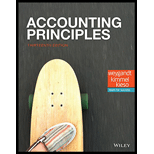
Concept explainers
(a)
Perpetual Inventory System: Perpetual Inventory System refers to the inventory system that maintains the detailed records of every inventory transactions related to purchases and sales on a continuous basis. It shows the exact on-hand-inventory at any point of time.
Periodic Inventory System: It is a system in which the inventory is updated in the accounting records on a periodic basis such as at the end of each month, quarter or year. In other words, it is an accounting method which is used to determine the amount of inventory at the end of each accounting period.
Inventory cost flow: It refers to the flow (movement) of inventory when it is purchased or sell by the business organization.
The various inventory cost flow methods are:
- First-in, first-out (FIFO)
- Last in, first-out (LIFO)
- Average-cost
FIFO method: In FIFO method, those goods are sold first which are purchased first by the business organization.
LIFO method: In LIFO method, those goods are sold first which are purchased in last by the business organization
Average-cost method: In average-cost method, the value of inventory is calculated by the average of cost of goods sold which are available for the sale purpose for that period.
To determine: The amount of ending inventory under FIFO, LIFO, and Moving-average cost.
(b)
Compare results of part (a) with results of E6-4.
(c)
The method which will provide same amount of ending inventory under periodic and perpetual inventory system, and the method which will provide different ending inventory under both inventory system.
Want to see the full answer?
Check out a sample textbook solution
Chapter 6 Solutions
EBK ACCOUNTING PRINCIPLES
- At the beginning of the year, Quasar Systems had liabilities of $92,000. During the year, assets increased by $68,000, and at year-end, assets totaled $225,000. Liabilities decreased by $17,000 during the year. What are the beginning and ending amounts of equity for Quasar Systems?arrow_forwardPlease provide the correct solution to this financial accounting question using valid principles.arrow_forwardI need guidance with this general accounting problem using the right accounting principles.arrow_forward
- The financial statements of Isabella Corporation report net sales of $840,000 and accounts receivable of $175,000 and $135,000 at the beginning and end of the year, respectively. What is the average collection period for accounts receivable in days? Need helparrow_forwardCompute the labor quantity variance.arrow_forwardI am trying to find the accurate solution to this general accounting problem with appropriate explanations.arrow_forward
- Can you provide a detailed solution to this financial accounting problem using proper principles?arrow_forwardCould you help me solve this financial accounting question using appropriate calculation techniques?arrow_forwardPlease explain the solution to this general accounting problem with accurate explanations.arrow_forward

 AccountingAccountingISBN:9781337272094Author:WARREN, Carl S., Reeve, James M., Duchac, Jonathan E.Publisher:Cengage Learning,
AccountingAccountingISBN:9781337272094Author:WARREN, Carl S., Reeve, James M., Duchac, Jonathan E.Publisher:Cengage Learning, Accounting Information SystemsAccountingISBN:9781337619202Author:Hall, James A.Publisher:Cengage Learning,
Accounting Information SystemsAccountingISBN:9781337619202Author:Hall, James A.Publisher:Cengage Learning, Horngren's Cost Accounting: A Managerial Emphasis...AccountingISBN:9780134475585Author:Srikant M. Datar, Madhav V. RajanPublisher:PEARSON
Horngren's Cost Accounting: A Managerial Emphasis...AccountingISBN:9780134475585Author:Srikant M. Datar, Madhav V. RajanPublisher:PEARSON Intermediate AccountingAccountingISBN:9781259722660Author:J. David Spiceland, Mark W. Nelson, Wayne M ThomasPublisher:McGraw-Hill Education
Intermediate AccountingAccountingISBN:9781259722660Author:J. David Spiceland, Mark W. Nelson, Wayne M ThomasPublisher:McGraw-Hill Education Financial and Managerial AccountingAccountingISBN:9781259726705Author:John J Wild, Ken W. Shaw, Barbara Chiappetta Fundamental Accounting PrinciplesPublisher:McGraw-Hill Education
Financial and Managerial AccountingAccountingISBN:9781259726705Author:John J Wild, Ken W. Shaw, Barbara Chiappetta Fundamental Accounting PrinciplesPublisher:McGraw-Hill Education





